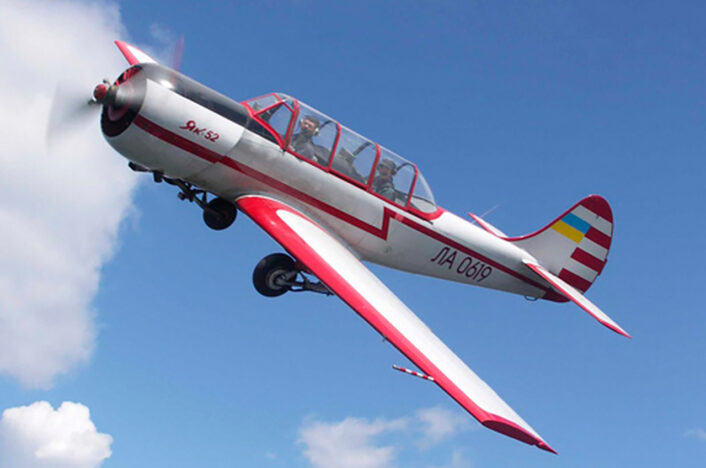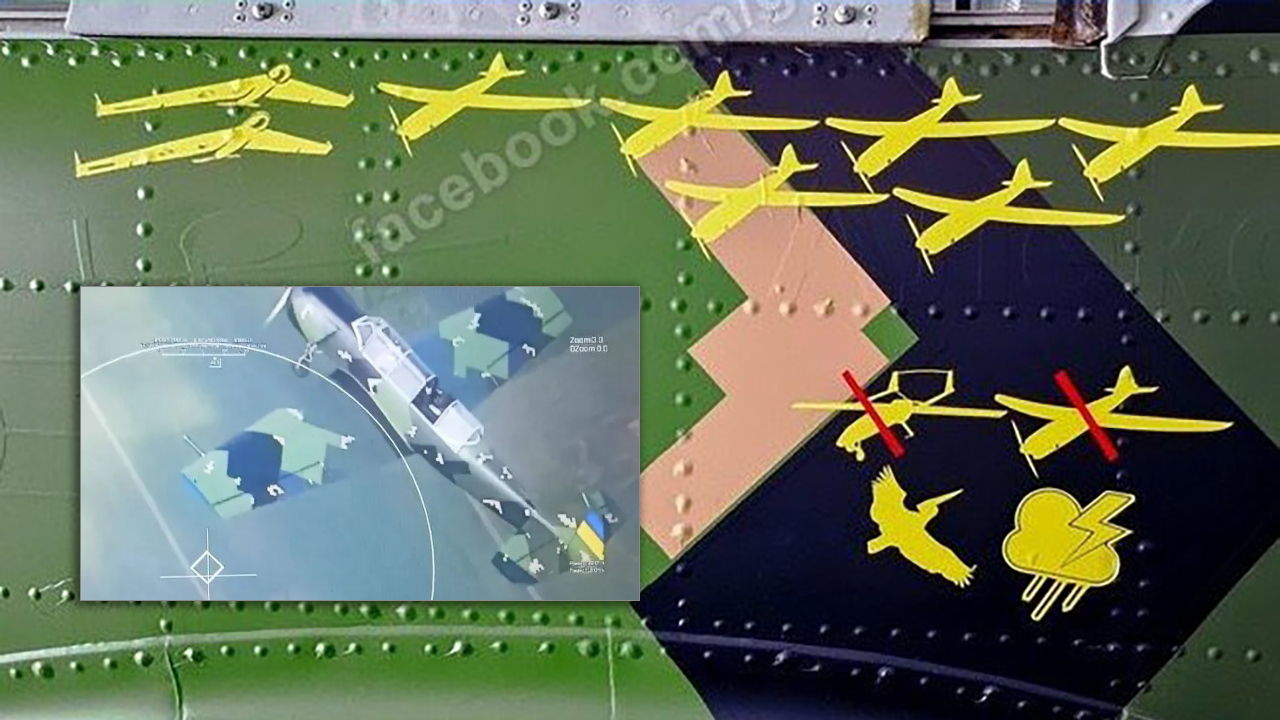The piston-prop training aircraft received kill marks for shooting down eight Russian drones, plus other two whose destruction was witnessed by the crew.
After multiple instances of air-to-air engagements between Ukrainian Yak-52s and Russian drones, one of the piston-prop training aircraft has now received kill marks showing its success as “drone hunter”. Two photos, later deleted, were recently posted on Facebook, showing the kill marks just below the canopy frame and the aircraft in a hangar while they were being applied.
In the last few weeks, in engagements reminiscent of WWII dogfights, reports emerged of the Ukrainian training aircraft being used to shoot down Russian drones, with at least two Russian Orlan 10 drones shown in videos descending with a parachute after being hit. Earlier this month, a video also showed the point of view of the target drone.
According to some sources, the Ukrainian trainers have not been retrofitted with wing or fuselage-mounted machine guns due to the extensive and technically challenging modifications required to integrate such weaponry into the airframe. The video from the drone shows the backseater as he’s about to pull out something from the cockpit, in line with the reports of the drones possibly being shot down with handheld guns or automatic weapons from the cockpit.
Kill marks of the crew of the Ukrainian Yak-52, which shoots down Russian reconnaissance drones.
P.S: As said in the comments, the bird and cloud at the bottom right are marking drones downed as a result of a collision with a bird and exposure to weather, which was witnessed by… https://t.co/ziDvTwZXfy pic.twitter.com/1ZjnqHqw9Z
— Special Kherson Cat 🐈🇺🇦 (@bayraktar_1love) June 25, 2024
The kill marks appeared on the Yak-52 give an idea of the type of drones being brought down. In fact, the kill count of the trainer appears to be two ZALA 421-16E surveillance drones and six Orlan 10 surveillance/targeting drones. The latter is one of the most widely used UAVs by the Russian military.
There are also two other interesting marks, which shows the shape of an Iranian-made Mohajer-6 and another Orlan drone, both crossed by a red line. Below them there are, respectively, a large bird (seemingly a pelican) and a thunderstorm shape. According to the comments posted with the photos, the crew of the Yak-52 witnessed the destruction of the two drones by a bird strike and exposure to adverse weather, respectively.
The heavy activity of Russian drones over Ukraine is becoming increasingly problematic for the war-torn country, with a wide range of measures put in place to contrast the unmanned assets, from old-school searchlights and machineguns to more modern electronic warfare systems and surface-to-air missiles. The resort to the Yak-52 is only the latest addition to the air defense line-up, with at least two aircraft reported in this role.
The Yak-52
The Yakovlev Yak-52 is a Soviet-era primary trainer aircraft that was widely used for military pilot training. It was designed by Yakovlev Design Bureau and first flew in 1976. The Yak-52 is a two-seat, single-engine, all-metal monoplane with a low-wing configuration.
One of the distinctive features of the Yak-52 is its aerobatic capability but it is also known for its robust airframe, making it popular among aerobatics enthusiasts and airshow performers.

The Yak-52 is powered by a single Vedeneyev M-14P radial engine, providing sufficient power for aerobatic maneuvers and training flights. The aircraft has a tandem seating arrangement, with the student pilot sitting in the front and the instructor pilot in the rear. This configuration allows for effective training and communication between the pilot and instructor during flight.
In addition to its training role, the Yak-52 has also been used for light ground attack missions. The Yak-52B variant was built with the capability to carry GUV-8700 pods with machine guns or UB-32 pods with unguided rockets for ground attack missions, however this configuration was produced only in one example.
The aircraft’s slow stall speed makes it perfect for SMI (Slow Movers Intercept) missions like the ones reportedly being carried out over Ukraine against the Russian drones. In fact, while MiG-29s and Su-27s are also being employed to counter the drones, they are forced to fly at very low speeds at the limits of their flight envelope, in addition to having to use more expensive weapons.













